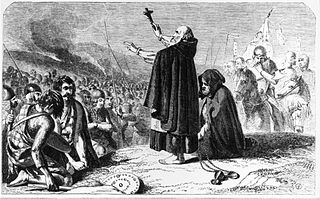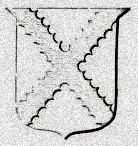
Maurice was a 14th-century Scottish cleric who became Prior of Inchmahome, Abbot of Inchaffray and then Bishop of Dunblane. He was Prior of Inchmahome Priory in Menteith after 1297. He became abbot of Inchaffray Abbey in Strathearn between March 1304 and October 1305. As Abbot of Inchaffray, he held a canonry in the diocese of Dunblane, that is, the precentorship of Dunblane Cathedral. After the death of Nicholas de Balmyle, he was elected to the bishopric of Dunblane. He was consecrated to the see before 23 March 1322, after litigation at the Papal court. King Edward II of England had nominated one Richard de Pontefract to the see, while Roger de Ballinbreich had also been elected by the chapter; both of these men were overlooked by the Pope in Maurice's favour.
Michael Ochiltree [Ouchtre] was a 15th-century Scottish prelate and administrator. A close associate of King James I of Scotland, from the late 1410s he rose in rank from canon to Dean of Dunblane and then Bishop of Dunblane. He was responsible for the coronation of King James II of Scotland, and he obtained a grant from the crown which allowed the comparatively small diocese of Dunblane to attain historically unprecedented viability.
Robert Lauder was a Scottish prelate and Nuncio of the 15th century. The Lauder family produced a large number of senior churchman in this period, and alongside Robert can be named William Lauder, Bishop of Glasgow, Alexander Lauder and Thomas Lauder, both Bishop of Dunkeld, and George Lauder, Bishop of Argyll.
Thomas Tulloch [de Tulloch] was a prelate active in the Kingdom of Scotland in the 15th century. A letter of Pope Martin V in 1429 claimed that he was "of a great noble race by both parents". Robert Keith believed that he had the surname "Urquhart", but that is not supported by the contemporary evidence and is probably spurious.
Roger was a churchman based in the 14th century Kingdom of Scotland, and active as Bishop of Ross from 1325 until 1350. Before attaining this position, Roger was a canon of Abernethy; it is possible that Roger was an Augustinian, because it is often thought that Abernethy did not become a collegiate church until some time after 1328, after the marriage of the Abernethy heiress to the Earl of Angus; this however is not certain, as the exact details of Abernethy's transition from being an Céli Dé abbey to an Augustinian priory to a secular college are only vaguely understood.
Roger de Balnebrich [de Balnebrech, de Balnebriech, de Ballinbreth] was a 14th-century Scottish churchman. Roger received a university education, being styled Magister ("Master") by August 1313, though it is not known where he took his degree; the degree, however, was almost certainly done in canon law. His name derives either from Ballinbreich in Fife or Balnabriech, in Brechin, Angus.
Alexander Stewart was a 14th-century Scottish bishop. Probably from Menteith, he appears in the sources from the first half of the 1340s, possessing a university degree and holding the position of Archdeacon of Ross. He was active at the papal curia in the second half of the decade as a papal chaplain and administrator, before being provided as Bishop of Ross in 1350, a position he held until his death in 1371.
Alexander de Kylwos – written alternatively as Frylquhous, Kylquos, and a variety of other forms – was a Scottish churchman and prelate active in the second half of the 14th century. He is known to have held senior positions in three bishoprics, and senior offices in two, before being elected and appointed Bishop of Ross in 1371. Though his episcopate is relatively obscure, he seems to have spent almost all of it inside or around his province, was closely associated with William III and Euphemia I, successive rulers of Ross, and was an associate of the famous Alexander Bur, Bishop of Moray, during the latter's struggle with Alexander Stewart, the son of the King later known by the nickname "Wolf of Badenoch".

Albin was a 13th-century prelate of the Kingdom of Scotland. A university graduate, Albin is known for his ecclesiastical career in the diocese of Brechin, centred on Angus in east-central Scotland.
Laurence de Ergadia was a thirteenth-century Scottish bishop. Probably from the MacDougall kindred of Argyll, Laurence had become a Dominican friar and presumably university graduate before being elected Bishop of Argyll, an election which took place sometime between 1262 and 1264. Although the election was quashed by the Pope in 1264, the Pope gave him a fresh provision to the bishopric. Laurence appears intermittently in the records during his three and a half decade episcopate, but his activities in his own diocese are badly recorded. He died as Bishop of Argyll sometime in either 1299 or 1300.
Fionnlagh MacCailein or Finlay Colini was a medieval Scottish bishop. Both his early life and the details of his career as Bishop of Dunblane are not well known, however it is known that he held the latter bishopric between 1403 and his death in 1419. He was part of the circle of Robert Stewart, Duke of Albany, and was one of the many clerics from west and central Gaelic-speaking Scotland who benefited from the latter's patronage. He is said to have authorised the construction of the first bridge over the river Allan at Dunblane.
Dúghall of Lorne [or de Ergadia] was a late 14th century and early 15th century prelate in the Kingdom of Scotland. Probably a MacDúghaill (MacDougall) from the province of Lorne in Argyll, he appears to have studied at the University of Oxford before returning to Scotland for an ecclesiastical and administrative career. He obtained benefices in the diocese of Argyll, Dunkeld, Dunblane and St Andrews, and acted as the secretary and chaplain of Robert Stewart, Earl of Fife, before becoming Bishop of Dunblane. He held the bishopric of Dunblane until his death in 1403.
Simon is the third known 12th century Bishop of Dunblane. Nothing is known of Simon's background as there are numerous Simons in Scotland in this period, both native and foreign. There is a Symon de Liberatione who witnessed a charter of King William the Lion and whom Watt and Murray suggested may have been the later Bishop of Dunblane, while there was in the same decade a local landholder and ecclesiastical patron in the diocese of Dunblane called Simón son of Mac Bethad.

Nicholas de Balmyle, also called Nicholas of St Andrews, was a Scottish administrator and prelate in the late 13th century and early 14th century. A graduate of an unknown university, he served his earliest years as a clergyman at St Andrews, moving on to hold churches in Lothian as well as deputising to two archdeacons of Lothian.

Nicholas O. Tiron, Abbot of Arbroath and Bishop of Dunblane, was a late 13th-century and early 14th-century churchman in the Kingdom of Scotland. Little is known about Nicholas until he appeared on 21 November 1299, holding the position of Abbot of Arbroath in a charter of that abbey; the last attestation of his predecessor Henry can be dated to 16 October 1296, so that Nicholas must have become abbot sometime in between these two dates.
Andrew Magnus was a 14th-century Scottish prelate. Of unknown background, he is recorded for the first time in a document dating to 28 November 1365, holding the position of Archdeacon of Dunblane. Having merely been collated to this position by an ordinary, perhaps the Bishop of Dunblane Walter de Coventre, he received a fresh papal provision on 6 January 1367.
William de Cambuslang was a 14th-century Scottish churchman, presumably coming from a family based at or originating from Cambuslang near Glasgow.
Radulf is an obscure churchman in early 13th-century Scotland, elected as Bishop of Dunblane some time between 1223 and 1225. The first of only two notices of his existence occurs in an Arbroath Abbey deed where he is styled "Radulf elect of Dunblane"; the document can be dated to 1223–1225. On 12 January 1226 Pope Honorius III instructed the Bishop of St Andrews, the Bishop of Moray and the Bishop of Caithness, to enjoin a new election for the bishopric of Dunblane, as "R. elected Bishop of Dunblane" had resigned in the Pope's presence a short time before. There are no clues as to Radulf's career after that. The Cathedral chapter of the diocese elected one Osbert in his place. Cockburn suggested Radulf was probably a Frenchman who had immigrated to Scotland, who got elected Bishop, but decided he would rather stay in Continental Europe after he travelled there for consecration, perhaps being offered a better post there.
William O. Tiron. was a late 13th-century Tironensian abbot and bishop in the Kingdom of Scotland. He appears in the extant sources for the first time on 25 April 1276; he is Abbot of Arbroath. According to the Scotichronicon, the work of the 15th-century historian Walter Bower, William's predecessor Adam de Inverlunan had died in 1275, so William probably became abbot in either that year or in 1276.
Jonathan was a churchman and prelate active in late twelfth- and early thirteenth century Strathearn, in the Kingdom of Scotland. He was the Bishop of Dunblane during the time of Gille Brigte of Strathearn, and it was during Jonathan's episcopate that Gille Brigte founded an Augustinian priory at Inchaffray.





